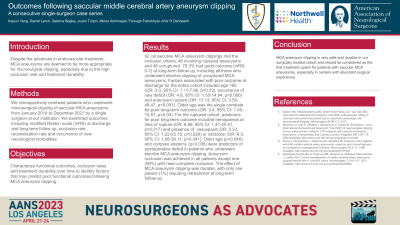Outcomes following saccular middle cerebral artery aneurysm clipping: A consecutive single-surgeon case series
Outcomes Following Saccular Middle Cerebral Artery Aneurysm Clipping: A Consecutive Single-surgeon Case Series
Friday, April 21, 2023

.jpg)
Daniel G. Lynch
Medical Student Research Fellow
Zucker School of Medicine at Hofstra/Northwell
Long Island City, New York, United States
ePoster Presenter(s)
Introduction: Despite the advances in endovascular treatment, MCA aneurysms are deemed to be more appropriate for microsurgical clipping, especially due to the high occlusion rate and treatment durability.
Methods: We retrospectively reviewed patients who underwent microsurgical clipping of saccular MCA aneurysms from January 2014 to December 2021 by a single surgeon at our institution. We examined outcomes including modified Rankin scale (mRS) at discharge and long-term follow up, occlusion rate, recanalization rate and occurrence of new neurological morbidities.
Results: We identified 92 consecutive MCA aneurysm clipping procedures that met the inclusion criteria, including operations on 46 ruptured and 46 unruptured aneurysms. 79.3% of all patients had good outcome (mRS 0-2) at long-term follow up. Factors associated with poor outcome at the time of the discharge for the entire cohort included older age (>65, OR: 3.0, 95% CI: 1.11-7.96, p=0.03), occurrence of new neurological morbidities (OR: 4.8, 95% CI: 1.55-14.94, p=0.006) and aneurysm rupture (OR: 13.13, 95% CI: 3.56-48.47, p< 0.001). Older age remained the single correlate for poor long-term outcome (OR: 3.4, 95% CI: 1.05-10.81, p=0.04). For the ruptured cohort, predictors for poor long-term outcome included hemiparesis at time of rupture (OR: 8.66, 95% CI: 1.47-50.91, p=0.017), vasospasm requiring treatment (OR: 5.33, 95% CI: 1.22-23.19, p=0.026), and infarction (OR: 6.5, 95% CI: 1.08-39.11, p=0.041). Older age (p=0.046) and complex aneurysm morphology (p=0.036) were predictors of new neurological morbidities following elective clipping. Aneurysm occlusion was achieved in all patients except one (99%). The effect of MCA aneurysm clipping was durable, with only one patient (1%) requiring retreatment at long-term follow-up.
Conclusion : MCA aneurysm clipping was observed to be a safe and durable procedure in our cohort and may be a viable first-line treatment option for patients with saccular MCA aneurysms, especially in centers with abundant surgical experience
Methods: We retrospectively reviewed patients who underwent microsurgical clipping of saccular MCA aneurysms from January 2014 to December 2021 by a single surgeon at our institution. We examined outcomes including modified Rankin scale (mRS) at discharge and long-term follow up, occlusion rate, recanalization rate and occurrence of new neurological morbidities.
Results: We identified 92 consecutive MCA aneurysm clipping procedures that met the inclusion criteria, including operations on 46 ruptured and 46 unruptured aneurysms. 79.3% of all patients had good outcome (mRS 0-2) at long-term follow up. Factors associated with poor outcome at the time of the discharge for the entire cohort included older age (>65, OR: 3.0, 95% CI: 1.11-7.96, p=0.03), occurrence of new neurological morbidities (OR: 4.8, 95% CI: 1.55-14.94, p=0.006) and aneurysm rupture (OR: 13.13, 95% CI: 3.56-48.47, p< 0.001). Older age remained the single correlate for poor long-term outcome (OR: 3.4, 95% CI: 1.05-10.81, p=0.04). For the ruptured cohort, predictors for poor long-term outcome included hemiparesis at time of rupture (OR: 8.66, 95% CI: 1.47-50.91, p=0.017), vasospasm requiring treatment (OR: 5.33, 95% CI: 1.22-23.19, p=0.026), and infarction (OR: 6.5, 95% CI: 1.08-39.11, p=0.041). Older age (p=0.046) and complex aneurysm morphology (p=0.036) were predictors of new neurological morbidities following elective clipping. Aneurysm occlusion was achieved in all patients except one (99%). The effect of MCA aneurysm clipping was durable, with only one patient (1%) requiring retreatment at long-term follow-up.
Conclusion : MCA aneurysm clipping was observed to be a safe and durable procedure in our cohort and may be a viable first-line treatment option for patients with saccular MCA aneurysms, especially in centers with abundant surgical experience
